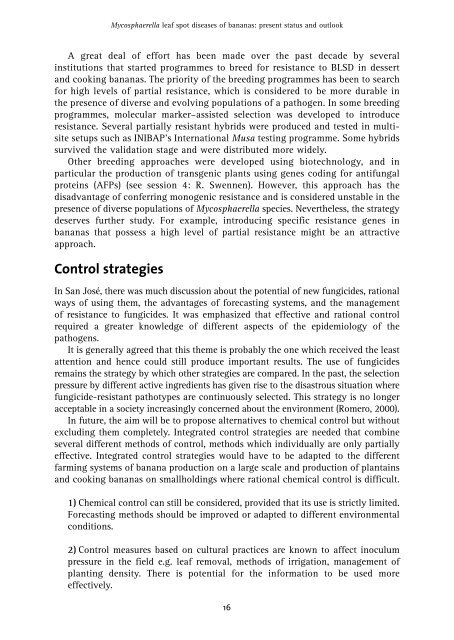Mycosphaerella leaf spot diseases of bananas - CBS
Mycosphaerella leaf spot diseases of bananas - CBS
Mycosphaerella leaf spot diseases of bananas - CBS
You also want an ePaper? Increase the reach of your titles
YUMPU automatically turns print PDFs into web optimized ePapers that Google loves.
<strong>Mycosphaerella</strong> <strong>leaf</strong> <strong>spot</strong> <strong>diseases</strong> <strong>of</strong> <strong>bananas</strong>: present status and outlook<br />
A great deal <strong>of</strong> effort has been made over the past decade by several<br />
institutions that started programmes to breed for resistance to BLSD in dessert<br />
and cooking <strong>bananas</strong>. The priority <strong>of</strong> the breeding programmes has been to search<br />
for high levels <strong>of</strong> partial resistance, which is considered to be more durable in<br />
the presence <strong>of</strong> diverse and evolving populations <strong>of</strong> a pathogen. In some breeding<br />
programmes, molecular marker–assisted selection was developed to introduce<br />
resistance. Several partially resistant hybrids were produced and tested in multisite<br />
setups such as INIBAP’s International Musa testing programme. Some hybrids<br />
survived the validation stage and were distributed more widely.<br />
Other breeding approaches were developed using biotechnology, and in<br />
particular the production <strong>of</strong> transgenic plants using genes coding for antifungal<br />
proteins (AFPs) (see session 4: R. Swennen). However, this approach has the<br />
disadvantage <strong>of</strong> conferring monogenic resistance and is considered unstable in the<br />
presence <strong>of</strong> diverse populations <strong>of</strong> <strong>Mycosphaerella</strong> species. Nevertheless, the strategy<br />
deserves further study. For example, introducing specific resistance genes in<br />
<strong>bananas</strong> that possess a high level <strong>of</strong> partial resistance might be an attractive<br />
approach.<br />
Control strategies<br />
In San José, there was much discussion about the potential <strong>of</strong> new fungicides, rational<br />
ways <strong>of</strong> using them, the advantages <strong>of</strong> forecasting systems, and the management<br />
<strong>of</strong> resistance to fungicides. It was emphasized that effective and rational control<br />
required a greater knowledge <strong>of</strong> different aspects <strong>of</strong> the epidemiology <strong>of</strong> the<br />
pathogens.<br />
It is generally agreed that this theme is probably the one which received the least<br />
attention and hence could still produce important results. The use <strong>of</strong> fungicides<br />
remains the strategy by which other strategies are compared. In the past, the selection<br />
pressure by different active ingredients has given rise to the disastrous situation where<br />
fungicide-resistant pathotypes are continuously selected. This strategy is no longer<br />
acceptable in a society increasingly concerned about the environment (Romero, 2000).<br />
In future, the aim will be to propose alternatives to chemical control but without<br />
excluding them completely. Integrated control strategies are needed that combine<br />
several different methods <strong>of</strong> control, methods which individually are only partially<br />
effective. Integrated control strategies would have to be adapted to the different<br />
farming systems <strong>of</strong> banana production on a large scale and production <strong>of</strong> plantains<br />
and cooking <strong>bananas</strong> on smallholdings where rational chemical control is difficult.<br />
1) Chemical control can still be considered, provided that its use is strictly limited.<br />
Forecasting methods should be improved or adapted to different environmental<br />
conditions.<br />
2) Control measures based on cultural practices are known to affect inoculum<br />
pressure in the field e.g. <strong>leaf</strong> removal, methods <strong>of</strong> irrigation, management <strong>of</strong><br />
planting density. There is potential for the information to be used more<br />
effectively.<br />
16

















